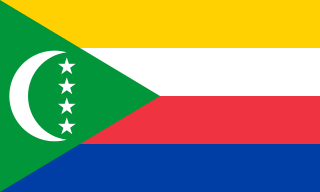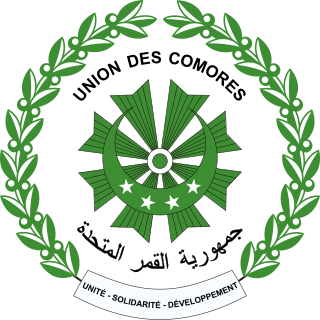
The Comoros, officially the Union of the Comoros, is an independent country made up of three islands in Southeastern Africa, located at the northern end of the Mozambique Channel in the Indian Ocean. Its capital and largest city is Moroni. The religion of the majority of the population, and the official state religion, is Sunni Islam. Comoros proclaimed its independence from France on 6 July 1975. A member of the Arab League, it is the only country in the Arab world which is entirely in the Southern Hemisphere. It is a member state of the African Union, the Organisation internationale de la Francophonie, the Organisation of Islamic Cooperation, and the Indian Ocean Commission. The country has three official languages: Shikomori, French and Arabic.

A crescent shape is a symbol or emblem used to represent the lunar phase in the first quarter, or by extension a symbol representing the Moon itself.

Anjouan is an autonomous volcanic island in the Comoro Islands in the southwestern Indian Ocean, part of the Union of the Comoros. It is known in Shikomori as Ndzuani, Ndzuwani or Nzwani, and, until the early twentieth century when the name fell out of general use, in English as Johanna. Historically it was also called Hinzuan or Hanzoan.

The national flag of the Islamic Emirate of Afghanistan, also used as the flag of the Taliban, consists of a white field with a black Shahada. It was adopted on 15 August 2021 with the victory of the Taliban in the 2001–2021 war. Since the Anglo-Afghan War of 1919, also known as the War of Independence, Afghanistan has used about 19 national flags, more than any other country in this period. The national flag had black, red and green colors most of the time during the period.

Azali Assoumani is a Comorian politician and military officer who has served as President of the Comoros since April 2019. He was also president from 2002 to 2006 and 2016 to February 2019. He became head of state after staging a coup d'état in 1999 and was elected president in 2002, 2016 and April 2019. He has also served as Chairperson of the African Union since February 2023.

The national flag of the Union of the Comoros was designed in 2001 and officially adopted on 23 December 2001. It continues to display the crescent and four stars, which is a motif that has been in use in slightly various forms since 1975 during the independence movement. In its constitution, the government of the Comoros refers to the insignia as l'emblème national, or the "national emblem", though it is understood to actually represent a flag.

The flag of Mauritania is a green field containing a gold star and crescent, with two red stripes at the top and bottom of the field. The original national flag was introduced under the instructions of President Moktar Ould Daddah and the constitution of 22 March 1959 and was adopted on 1 April 1959.

The flag of Tunisia is a rectangular panel of red color with an aspect ratio of 2:3. In the center of the cloth in a white circle is placed a red crescent, surrounding a red five-pointed star on three sides. The Tunisian Bey Hussein II decided to create a flag for Tunisia, close in appearance to the modern one, after the Battle of Navarino on 20 October 1827; in 1831 he was officially approved. In that form, the flag existed during the French protectorate, and on 1 June 1959, it was proclaimed the state flag of the Republic of Tunisia. On 30 June 1999, the proportions and design of the flag were clarified by a special law. The general appearance of the flag remained virtually unchanged.

The national emblem of Algeria is the seal used by the government, as other states use coats of arms.

The star and crescent is an iconographic symbol used in various historical contexts, including as a prominent symbol of the Ottoman Empire, and in contemporary times used as a national symbol for some countries, and a recognized symbol of Islam. It was developed in the Greek colony of Byzantium ca. 300 BC, though it became more widely used as the royal emblem of Pontic king Mithridates VI Eupator after he incorporated Byzantium into his kingdom for a short period. During the 5th century, it was present in coins minted by the Persian Sassanian Empire; the symbol was represented in the coins minted across the empire throughout the Middle East for more than 400 years from the 3rd century until the fall of the Sassanians after the Muslim conquest of Persia in the 7th century. The conquering Muslim rulers kept the symbol in their coinage during the early years of the caliphate, as the coins were exact replicas of the Sassanian coins.

Elections in the Comoros take place within the framework of a multi-party democracy and a presidential system. The President and the majority of the seats in the Assembly of the Union are directly elected.

The Great Seal of Missouri is used to authenticate certain documents issued by the Government of Missouri. The phrase is used both for the physical seal itself, which is kept by the secretary of state, and more generally for the design impressed upon it. The Great Seal was designed by Robert Wells of Jefferson City.

Since 2011, Libya currently does not have an official national emblem. The Constitutional Declaration issued by the National Transitional Council on August 2011 defines the flag of Libya, but does not make any provisions for a coat of arms.

The following outline is provided as an overview of and topical guide to Comoros:

During the Mandate period in Palestine, between 1920 and 1948, when Palestine was governed by Britain under terms which were formalised in the League of Nations Mandate for Palestine of July 24, 1922, the de facto flag was the Union Jack or Union Flag of the United Kingdom, but several localised flags existed for Mandate government departments and government officials. The only Palestine-specific flag not restricted to official government use was the Palestine ensign, which was flown by ships registered in the British Mandate territory from 1927 to 1948. It was based on the British Red Ensign instead of the Blue Ensign since it was intended for use only at sea by non-government ships.
The Comoros Red Crescent Society was founded in 1982, and it is the part of the recognition by the International Red Cross and Red Crescent Movement in 2005. The national headquarters of The Comoros Red Crescent is in Moroni and the other three regional branches are each located are Grande Comore, Anjouan, and Moheli islands of the Comoros. The warehouse which it was built in 2013 with the help from The French Development Agency of France. But they can store 80 tonnes of relief supplies. There are 6,600 Members, 3,600 Volunteers, and 11 Salaried employees of The Comoros Red Crescent Authority.
















